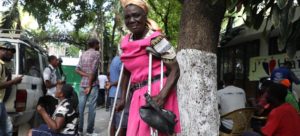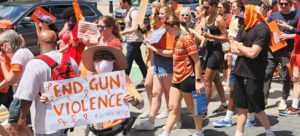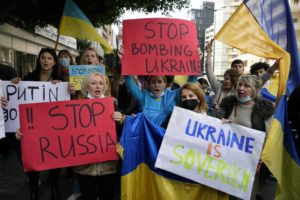The Supreme Court voted 5-4 to bar New York state from reimposing limits on religious gatherings.
The Supreme Court signaled a major shift in its approach to coronavirus-related restrictions late Wednesday, voting 5-4 to bar New York state from reimposing limits on religious gatherings.
The emergency rulings, issued just before midnight, were the first significant indication of a rightward shift in the court since President Donald Trump’s newest appointee — Justice Amy Coney Barrett — last month filled the seat occupied by liberal Justice Ruth Bader Ginsburg, who died in September.
In May and July, the Supreme Court narrowly rejected challenges to virus-related restrictions on churches in California and Nevada, with Chief Justice John Roberts joining the court’s Democratic appointees to stress that state and local governments required flexibility to deal with a dangerous and evolving pandemic.
But support on the high court for those rulings shrank with Ginsburg’s death. Wednesday night’s orders granting emergency relief to Roman Catholic churches and to Jewish congregations in New York demonstrated, as many suspected, that Barrett would side with the court’s most conservative justices in insisting on greater accommodation for religion even as the pandemic is again surging.
“Stemming the spread of COVID–19 is unquestionably a compelling interest, but it is hard to see how the challenged regulations can be regarded as ‘narrowly tailored,’” the court wrote in an unsigned opinion. “They are far more restrictive than any COVID–related regulations that have previously come before the Court, much tighter than those adopted by many other jurisdictions hard-hit by the pandemic, and far more severe than has been shown to be required to prevent the spread of the virus at the applicants’ services.”
Barrett did not write a separate opinion in the two New York cases, but the orders signaled that she was part of the majority backing the court’s controlling, unsigned opinion.
Roberts and the court’s three remaining Democratic appointees dissented, stressing that the emergency relief wasn’t necessary because Gov. Andrew Cuomo recently reclassified the areas in question in a color-coded system from “orange” to “yellow,” lifting the most onerous restrictions.
Under New York’s system, religious services held by congregations in “red” zones are limited to 10 people, while those in “orange” zones can host up to 25 people at a time. On Monday, Cuomo moved the areas occupied by the religious congregations involved in the litigation into the “yellow” zone, lifting the most onerous restrictions, but areas in Staten Island and in Monroe and Onondaga Counties are now under the “orange” limits.
Roberts said the limits on religious activities under “orange” or “red” restrictions in New York may violate the Constitution, but he warned against jumping into that issue when no such limits were currently in effect on the congregations who petitioned the court.
“It may well be that such restrictions violate the Free Exercise Clause. It is not necessary, however, for us to rule on that serious and difficult question at this time,” the chief justice wrote in a solo dissent. “The Governor might reinstate the restrictions. But he also might not. And it is a significant matter to override determinations made by public health officials concerning what is necessary for public safety in the midst of a deadly pandemic.”
“I fear that granting applications such as the one filed by the Roman Catholic Diocese of Brooklyn … will only exacerbate the Nation’s suffering,” Justice Sonia Sotomayor wrote in a somber dissent joined by Justice Elena Kagan.
Sotomayor vigorously disputed the contention that the religious groups were being unfairly discriminated against, arguing that comparisons between religious services and liquor or big-box stores were overly facile because the virus-related health risks posed by what people do in those places are starkly different.
“Unlike religious services … bike repair shops and liquor stores generally do not feature customers gathering inside to sing and speak together for an hour or more at a time,” she wrote. “Justices of this Court play a deadly game in second guessing the expert judgment of health officials about the environments in which a contagious virus, now infecting a million Americans each week, spreads most easily.”
The latest virus-related ruling also triggered an unusually caustic exchange, albeit in writing, between Justice Neil Gorsuch and Roberts.
Gorsuch appeared to skewer and diminish Roberts’ concurring opinion in the California cases that went before the court on an emergency basis in May.
“As we round out 2020 and face the prospect of entering a second calendar year living in the pandemic’s shadow, that rationale has expired according to its own terms,” Gorsuch wrote. “Even if the Constitution has taken a holiday during this pandemic, it cannot become a sabbatical. Rather than apply a nonbinding and expired concurrence … courts must resume applying the Free Exercise Clause.”
Gorsuch also accused Roberts of “a serious rewriting of history” for now insisting that his May opinion did not rely on a century-old Supreme Court precedent that allowed mandatory smallpox vaccinations in Massachusetts.
“We may not shelter in place when the Constitution is under attack. Things never go well when we do,” Gorsuch warned.
But Roberts noted that Gorsuch on Wednesday devoted three pages of his opinion to “exactly one sentence” the chief justice wrote in May referring back to the 1905 smallpox vaccination case, Jacobson v. Massachusetts.
“What did that one sentence say? Only that ‘[o]ur Constitution principally entrusts “[t]he safety and the health of the people” to the politically accountable officials of the States “to guard and protect,”’” Roberts wrote.
“It is not clear which part of this lone quotation today’s concurrence finds so discomfiting … But the actual proposition asserted should be uncontroversial, and the concurrence must reach beyond the words themselves to find the target it is looking for.”
A Pasadena, Calif., church’s bid for emergency relief from that state’s Covid-19 restrictions is still pending at the court. After Wednesday’s ruling in the New York cases, the high court said the state’s deadline to respond from Friday afternoon to Monday afternoon, apparently to give lawyers time to digest the New York decision.




